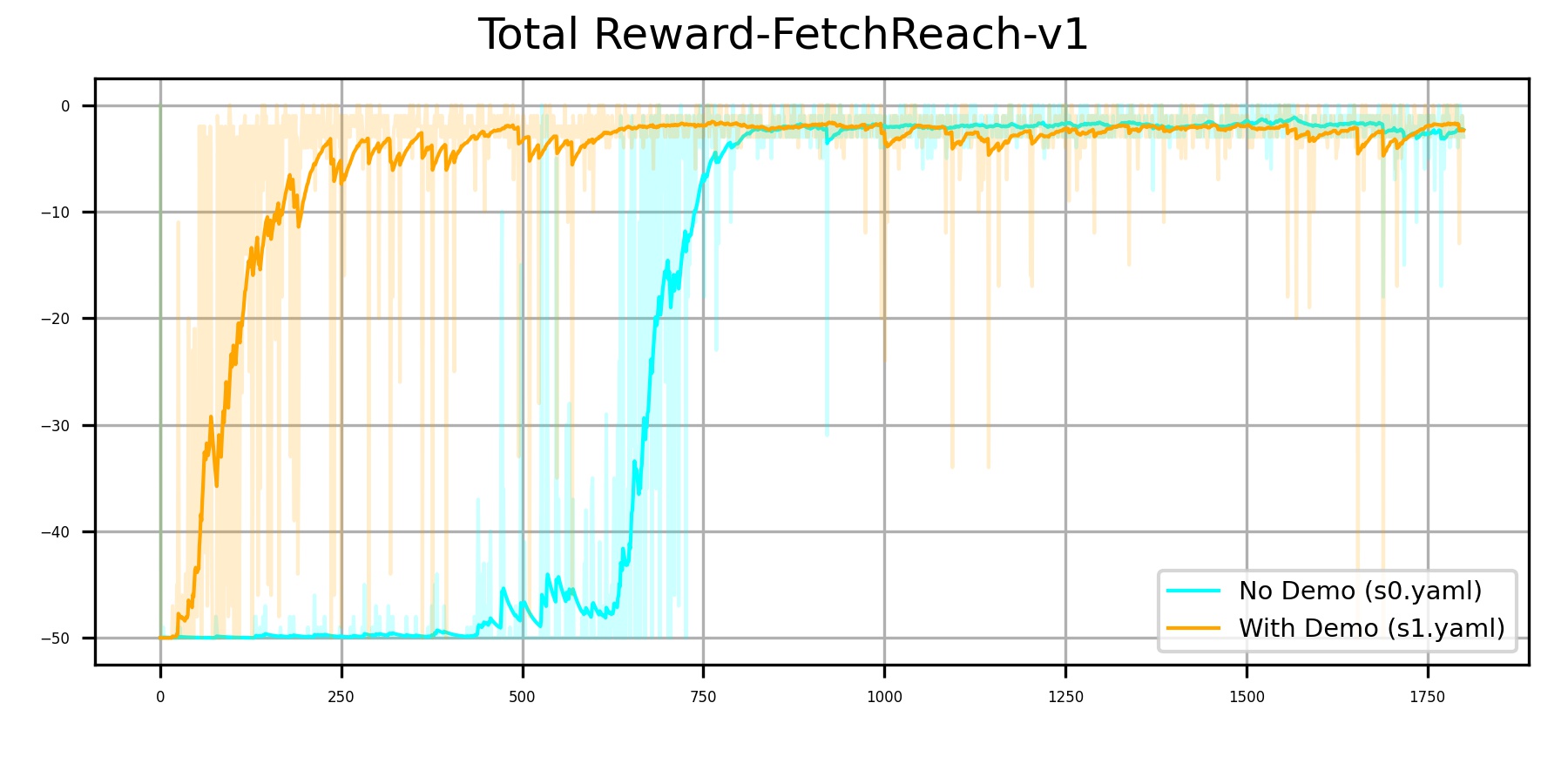This project implements the DDPG from Demonstration algorithm (DDPGfD, [1]) on a simple control task.
The DDPGfD algorithm suggests the following settings for improvement:
-
Always keep the demonstration data in the replay buffer and assign them with high priority. Specifically, priority for a transition tuple
$(s_t,a_t,G_{t:t+n},s_{t+n+1},\gamma^{n+1})_i$ is$p_{i}=\delta_{i}^{2}+\lambda\left|\nabla_{a} Q\left(s_{i}, a_{i} \mid \theta^{Q}\right)\right|^{2}+\epsilon+\epsilon_{D}$ , where$\delta_i$ : last TD error$|\nabla_{a} Q(s_{i}, a_{i} | \theta^{Q})|^{2}$ : actor loss$\epsilon$ : small constant (0.001)$\epsilon_D$ : large demonstration priority constant (0.99)$\lambda$ : balancing factor -
Mix of 1-step and
$N$ -step return in the replay buffer for updating the critic function$R_{n}=\sum_{i=0}^{n-1} \gamma^{i} r_{i}+\gamma^{n} Q\left(s_{n-1}^{\prime}, \pi\left(s_{n-1}^{\prime}\right) ; \theta^{Q^{\prime}}\right)$ $L_{n}\left(\theta^{Q}\right)=\frac{1}{2}\left(R_{n}-Q\left(s, \pi(s) \mid \theta^{Q}\right)\right)^{2}$ -
Pre-training the critic using the demonstration data
-
Multiple learning update per environment step
-
L2 Regularization (weight decay) on actor and critic networks
We use the environment FetchReach-v1 from openai gym. You can modify the models for other environments. All the hyper-parameters are shown in the configuration file under the config folder. Some important parameters are listed below.
- Two hidden linear layers with size 512.
- Tanh as the activation function for the last layer of the actor.
- Const learning rate:
$5\times10^{-4}$ - Weight decay:
$1\times10^{-5}$ - Training episodes: 1800
- Batch size: 4096 (sample size from replay buffer)
- Update step: 5 (at each environment step)
- Soft update:
$\tau=0.3$ (ratio of the behavior network) -
$N$ -step:$N=10$ $\gamma=0.9$ - Replay buffer: size=$10^5$
- 100 trajectories from a learned policy trained with 1800 episodes.
- Pre-train 10000 steps on the critic.
We provide all the weight files and training configurations used in this project. You can simply jump to Step4 to check the learned policy with demonstration.
python train.py config/s0.yaml
Modify the line 9 of config/s0.yaml
restore: true # Restore for training or evaluationthen run
python train.py config/s0.yaml --collect
You can also specify the specific number of trajectories you'd like to collect. E.g.,
python train.py config/s0.yaml --collect -n_collect 200
Modify the lines 47-48 of config/s1.yaml
demo_config:
load_demo_data: true
demo_dir: './data/demo'
demo_N: 100 # fill in the number of trajectories you collect
load_N: 100 # fill in the number of trajectories you want to loadthen run
python train.py config/s1.yaml
You can manually modify the number of pre-training steps in the line 18 of s1.yaml
pretrain_step: 10000Make sure the restore flag in the line 9 of your config (E.g., config/s1.yaml) is set to true.
restore: true # Restore for training or evaluationthen run
python train.py config/s1.yaml --eval
We provide the demonstration data in the data folder with 100 trajectories. These trajectories were collected from the learned policy using s0.yaml.
The code for analysis is included in train.py for FetchReach-v1 environment.
- Chun-Yu Chai: cychai.cs06g@nctu.edu.tw
- Yu-En Liu
- Keng-Fu Hsu
[1] Vecerik, Mel, et al. "Leveraging demonstrations for deep reinforcement learning on robotics problems with sparse rewards." arXiv preprint arXiv:1707.08817 (2017).
[2] Hester, Todd, et al. "Deep q-learning from demonstrations." Thirty-Second AAAI Conference on Artificial Intelligence. 2018.
